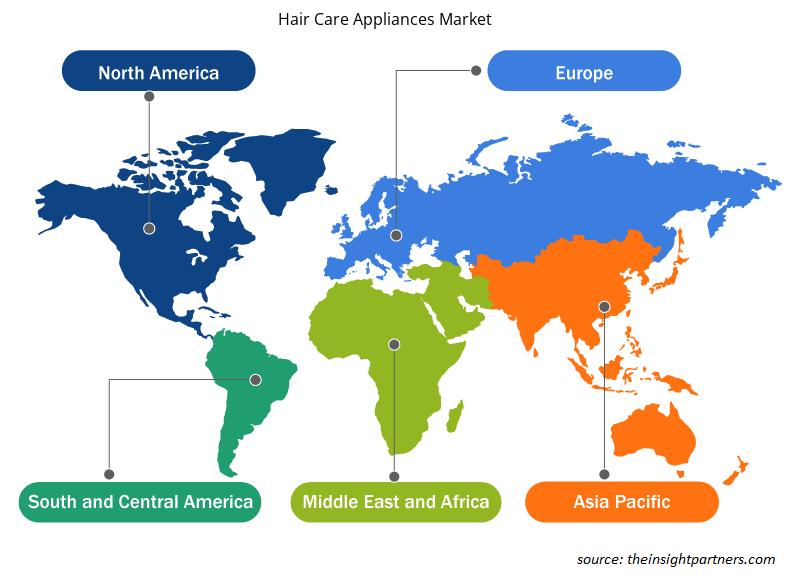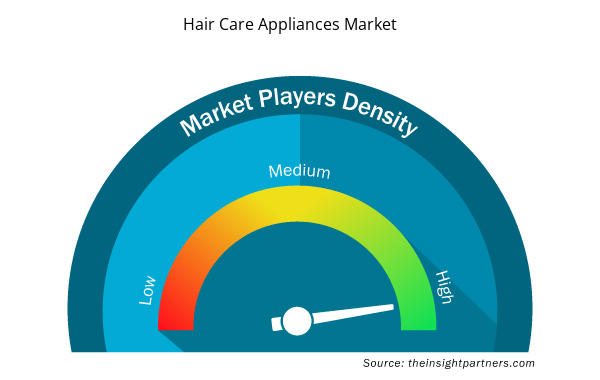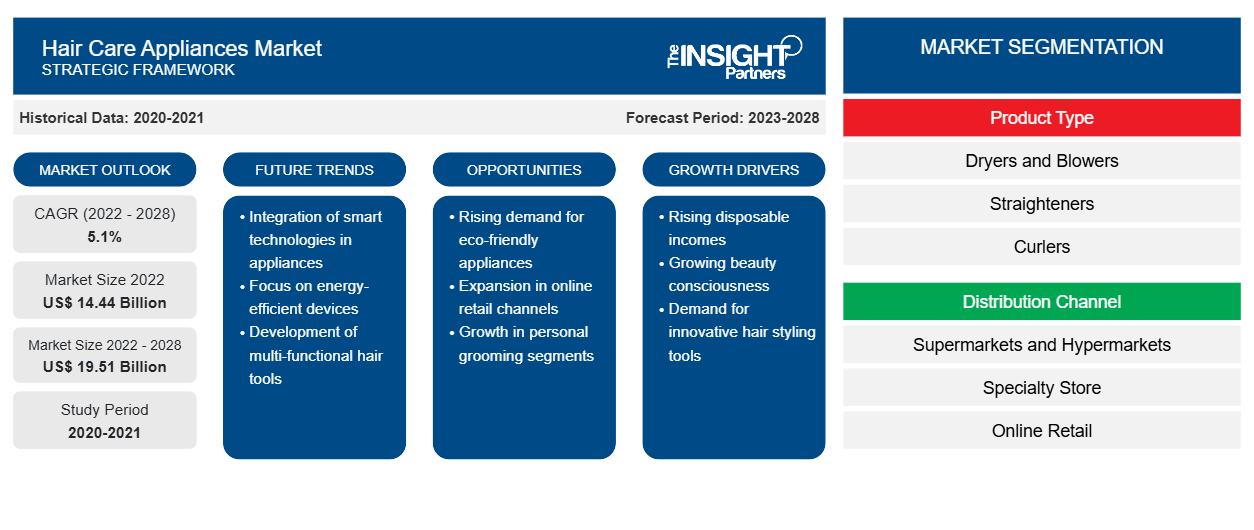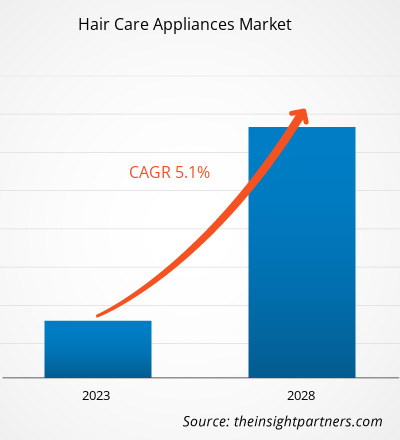预计美发用具市场规模将从 2022 年的 144.4023 亿美元增长至 2028 年的 195.1286 亿美元;预计 2022 年至 2028 年的复合年增长率为 5.1%。
人们越来越重视和关注自我修饰和个人形象,这增加了对护发器具的需求。这些器具有助于减少对头发的伤害,并以特定的方式塑造头发。
2021 年,亚太地区在全球护发器具市场占据主导地位。人们对头发健康的意识日益增强、社交媒体对消费者的影响力日益增强以及价格实惠的护发器具日益普及,是推动市场增长的主要因素。此外,亚太地区的护发器具制造商正在开发创新的护发器具。例如,2020 年 7 月,荷兰皇家飞利浦公司、飞利浦印度公司推出了一系列高科技护发设备,如直发器和吹风机,品牌为 SenseIQ。这些产品使用有源传感器在造型时测量头发的温度。一些市场参与者还计划在营销活动上投入更多资金,以提高消费者对其产品的认知度,这将在预测期内为市场提供增长机会。
定制此报告以满足您的需求
您可以免费定制任何报告,包括本报告的部分内容、国家级分析、Excel 数据包,以及为初创企业和大学提供优惠和折扣
- 获取此报告的关键市场趋势。这个免费样品将包括数据分析,从市场趋势到估计和预测。
市场洞察
产品创新将在预测期内提供有利可图的增长机会
护发器具制造商正在大力投资新产品开发,以推出能够满足消费者不断变化的需求的创新产品。消费者非常担心加热工具对头发造成的损害。因此,制造商正在开发具有温控技术的产品,即使长时间使用也不会对头发造成太大的伤害。例如,2020 年 1 月,FOLLICLE, LLC 推出了无线、可充电和智能吹风机,该吹风机采用了获得专利的 SmartDry AI Tech 技术,可以控制温度和风扇速度。同样,2021 年 9 月,全球家庭护理和美容电器制造商 SharkNinja Holding LLC 推出了 Shark HyperAIR 吹风机,该吹风机采用 HyperAIR IQ 技术,结合高速加热空气和电离空气,以最小的热损伤实现快速干燥。因此,预计各制造商创新护发器具的不断发展将在预测期内为市场提供增长机会。
产品类型洞察
根据产品类型,护发器具市场细分为吹风机和吹风机、直发器、卷发器等。2021 年,吹风机和吹风机细分市场占有最大的市场份额。吹风机 是一种机电设备,可将环境空气或热空气吹过湿发,以加速水分蒸发,从而吹干头发。吹风机可以更好地控制头发的形状和样式。
露华浓公司 (Revlon Inc.)、荷兰皇家飞利浦公司 (Koninklijke Philips NV)、戴森有限公司 (Dyson Limited)、Jemella Ltd.、Instyler、Kiss Products Inc.、Toni & Guy、Cloud Nine、T3 Micro Inc. 和 Conair LLC 是护发用品市场的几家主要参与者。主要参与者采用各种策略,例如并购和产品发布,以扩大其地理覆盖范围和消费者基础。
护发器具市场区域洞察
Insight Partners 的分析师已详尽解释了预测期内影响护发器具市场的区域趋势和因素。本节还讨论了北美、欧洲、亚太地区、中东和非洲以及南美和中美洲的护发器具市场细分和地理位置。

- 获取护发器具市场的区域特定数据
护发器具市场报告范围
| 报告属性 | 细节 |
|---|---|
| 2022 年市场规模 | 144.4亿美元 |
| 2028 年市场规模 | 195.1亿美元 |
| 全球复合年增长率(2022 - 2028) | 5.1% |
| 史料 | 2020-2021 |
| 预测期 | 2023-2028 |
| 涵盖的领域 | 按产品类型
|
| 覆盖地区和国家 | 北美
|
| 市场领导者和主要公司简介 |
|
护发器具市场参与者密度:了解其对业务动态的影响
护发器具市场正在快速增长,这得益于消费者偏好的不断变化、技术进步以及对产品优势的认识不断提高等因素导致的终端用户需求不断增加。随着需求的增加,企业正在扩大其产品范围,进行创新以满足消费者的需求,并利用新兴趋势,从而进一步推动市场增长。
市场参与者密度是指在特定市场或行业内运营的企业或公司的分布情况。它表明在给定市场空间中,相对于其规模或总市场价值,有多少竞争对手(市场参与者)存在。
在护发用具市场运营的主要公司有:
- 露华浓公司
- 荷兰皇家飞利浦公司
- 戴森有限公司
- Jemella 有限公司
- 英斯黛拉
免责声明:上面列出的公司没有按照任何特定顺序排列。

- 了解护发器具市场的主要参与者概况
报告亮点
- 护发器具行业的进步趋势,帮助参与者制定有效的长期战略
- 公司采用的业务增长战略来确保发达市场和发展中市场的增长
- 2020 年至 2028 年全球护发用具市场定量分析
- 各行业对护发器具的需求估计
- 害虫分析说明护发用具行业买家和供应商的效力
- 了解竞争激烈的市场形势和对护发器具的需求的最新发展
- 市场趋势和前景,以及决定市场增长的因素,包括驱动因素和限制因素
- 了解支撑全球护发用具市场增长商业利益的战略,帮助做出决策
- 毛巾卷市场在各个市场节点的规模
- 护发用具市场及其行业动态的详细概述和细分
- 各地区美发用具市场规模及增长潜力巨大
“2028 年护发器具市场分析”是一项针对消费品行业的专业深入研究,特别关注护发器具市场趋势分析。该报告旨在通过详细的市场细分提供市场概述。护发器具市场根据产品类型、分销渠道和地理位置进行细分。根据产品类型,市场细分为吹风机和吹风机、直发器、卷发器等。根据分销渠道,市场细分为超市和大卖场、专卖店、在线零售等。根据地理位置,护发器具市场主要细分为北美、欧洲、亚太地区、中东和非洲以及南美和中美洲。2021 年,吹风机和吹风机细分市场占有最大的市场份额,预计在预测期内也将成为增长最快的细分市场。
公司简介
- 露华浓公司
- 荷兰皇家飞利浦公司
- 戴森有限公司
- Jemella 有限公司
- 英斯黛拉
- 吻产品公司
- 托尼和盖伊
- 九霄云外
- T3 Micro 公司
- 康耐尔有限责任公司
- 历史分析(2 年)、基准年、预测(7 年)及复合年增长率
- PEST 和 SWOT 分析
- 市场规模价值/数量 - 全球、区域、国家
- 行业和竞争格局
- Excel 数据集



Report Coverage
Revenue forecast, Company Analysis, Industry landscape, Growth factors, and Trends

Segment Covered
This text is related
to segments covered.

Regional Scope
North America, Europe, Asia Pacific, Middle East & Africa, South & Central America

Country Scope
This text is related
to country scope.
常见问题
The increased availability of hair care appliances across various retail outlets at affordable prices is driving the demand for hair care appliances across the world. The availability of hair care appliances across various distribution channels including supermarkets & hypermarkets, specialty stores, and online retail is another factor driving the hair care appliances market. Consumers are increasingly purchasing various goods from online shopping platforms owing to heavy discounts, availability of a wide range of products of different brands, customer reviews and ratings, and home delivery services.
During the forecast period, the online retail segment is expected to be the fastest-growing segment. The increased availability of hair care appliances on online retail channels as well as an increasing number of online shoppers is expected to propel the growth of the online shopping segment.
In 2021, the supermarkets and hypermarkets segment held the largest market share of the global hair care appliances market. Supermarkets and hypermarkets are huge retail establishments offering an extensive range of products, such as groceries, personal care, and household products. These stores provide hair care appliances of various brands at reasonable prices, allowing shoppers to find the right product quickly.
In 2021, the hair dryer and blowers segment held the largest market share of the global hair care appliances market. The increased use of hair dryers by men across the world is driving the demand for dryers and blowers. Along with this, manufacturers are also offering products with innovative technologies, including ionic and tourmaline dryers with different attachments, speeds, and heat settings.
The major players operating in the hair care appliances market are Revlon Inc., Koninklijke Philips N.V., Dyson Limited, Jemella Ltd., Instyler, Kiss Products Inc., Toni & Guy, Cloud Nine, T3 Micro Inc., Conair LLC
In 2021, Asia-Pacific accounted for the largest share of the global hair care appliances market. The increased prevalence of hair health-conscious consumers, the growing influence of social media on consumers, and the increased availability of hair care appliances at affordable prices are primarily driving the hair care appliances market growth.
Trends and growth analysis reports related to Consumer Goods : READ MORE..
The List of Companies - Hair Care Appliances Market
- Revlon Inc.
- Koninklijke Philips N.V.
- Dyson Limited
- Jemella Ltd.
- Instyler
- Kiss Products Inc.
- Toni & Guy
- Cloud Nine
- T3 Micro Inc.
- Conair LLC
The Insight Partners performs research in 4 major stages: Data Collection & Secondary Research, Primary Research, Data Analysis and Data Triangulation & Final Review.
- Data Collection and Secondary Research:
As a market research and consulting firm operating from a decade, we have published and advised several client across the globe. First step for any study will start with an assessment of currently available data and insights from existing reports. Further, historical and current market information is collected from Investor Presentations, Annual Reports, SEC Filings, etc., and other information related to company’s performance and market positioning are gathered from Paid Databases (Factiva, Hoovers, and Reuters) and various other publications available in public domain.
Several associations trade associates, technical forums, institutes, societies and organization are accessed to gain technical as well as market related insights through their publications such as research papers, blogs and press releases related to the studies are referred to get cues about the market. Further, white papers, journals, magazines, and other news articles published in last 3 years are scrutinized and analyzed to understand the current market trends.
- Primary Research:
The primarily interview analysis comprise of data obtained from industry participants interview and answers to survey questions gathered by in-house primary team.
For primary research, interviews are conducted with industry experts/CEOs/Marketing Managers/VPs/Subject Matter Experts from both demand and supply side to get a 360-degree view of the market. The primary team conducts several interviews based on the complexity of the markets to understand the various market trends and dynamics which makes research more credible and precise.
A typical research interview fulfils the following functions:
- Provides first-hand information on the market size, market trends, growth trends, competitive landscape, and outlook
- Validates and strengthens in-house secondary research findings
- Develops the analysis team’s expertise and market understanding
Primary research involves email interactions and telephone interviews for each market, category, segment, and sub-segment across geographies. The participants who typically take part in such a process include, but are not limited to:
- Industry participants: VPs, business development managers, market intelligence managers and national sales managers
- Outside experts: Valuation experts, research analysts and key opinion leaders specializing in the electronics and semiconductor industry.
Below is the breakup of our primary respondents by company, designation, and region:

Once we receive the confirmation from primary research sources or primary respondents, we finalize the base year market estimation and forecast the data as per the macroeconomic and microeconomic factors assessed during data collection.
- Data Analysis:
Once data is validated through both secondary as well as primary respondents, we finalize the market estimations by hypothesis formulation and factor analysis at regional and country level.
- Macro-Economic Factor Analysis:
We analyse macroeconomic indicators such the gross domestic product (GDP), increase in the demand for goods and services across industries, technological advancement, regional economic growth, governmental policies, the influence of COVID-19, PEST analysis, and other aspects. This analysis aids in setting benchmarks for various nations/regions and approximating market splits. Additionally, the general trend of the aforementioned components aid in determining the market's development possibilities.
- Country Level Data:
Various factors that are especially aligned to the country are taken into account to determine the market size for a certain area and country, including the presence of vendors, such as headquarters and offices, the country's GDP, demand patterns, and industry growth. To comprehend the market dynamics for the nation, a number of growth variables, inhibitors, application areas, and current market trends are researched. The aforementioned elements aid in determining the country's overall market's growth potential.
- Company Profile:
The “Table of Contents” is formulated by listing and analyzing more than 25 - 30 companies operating in the market ecosystem across geographies. However, we profile only 10 companies as a standard practice in our syndicate reports. These 10 companies comprise leading, emerging, and regional players. Nonetheless, our analysis is not restricted to the 10 listed companies, we also analyze other companies present in the market to develop a holistic view and understand the prevailing trends. The “Company Profiles” section in the report covers key facts, business description, products & services, financial information, SWOT analysis, and key developments. The financial information presented is extracted from the annual reports and official documents of the publicly listed companies. Upon collecting the information for the sections of respective companies, we verify them via various primary sources and then compile the data in respective company profiles. The company level information helps us in deriving the base number as well as in forecasting the market size.
- Developing Base Number:
Aggregation of sales statistics (2020-2022) and macro-economic factor, and other secondary and primary research insights are utilized to arrive at base number and related market shares for 2022. The data gaps are identified in this step and relevant market data is analyzed, collected from paid primary interviews or databases. On finalizing the base year market size, forecasts are developed on the basis of macro-economic, industry and market growth factors and company level analysis.
- Data Triangulation and Final Review:
The market findings and base year market size calculations are validated from supply as well as demand side. Demand side validations are based on macro-economic factor analysis and benchmarks for respective regions and countries. In case of supply side validations, revenues of major companies are estimated (in case not available) based on industry benchmark, approximate number of employees, product portfolio, and primary interviews revenues are gathered. Further revenue from target product/service segment is assessed to avoid overshooting of market statistics. In case of heavy deviations between supply and demand side values, all thes steps are repeated to achieve synchronization.
We follow an iterative model, wherein we share our research findings with Subject Matter Experts (SME’s) and Key Opinion Leaders (KOLs) until consensus view of the market is not formulated – this model negates any drastic deviation in the opinions of experts. Only validated and universally acceptable research findings are quoted in our reports.
We have important check points that we use to validate our research findings – which we call – data triangulation, where we validate the information, we generate from secondary sources with primary interviews and then we re-validate with our internal data bases and Subject matter experts. This comprehensive model enables us to deliver high quality, reliable data in shortest possible time.


 获取此报告的免费样本
获取此报告的免费样本